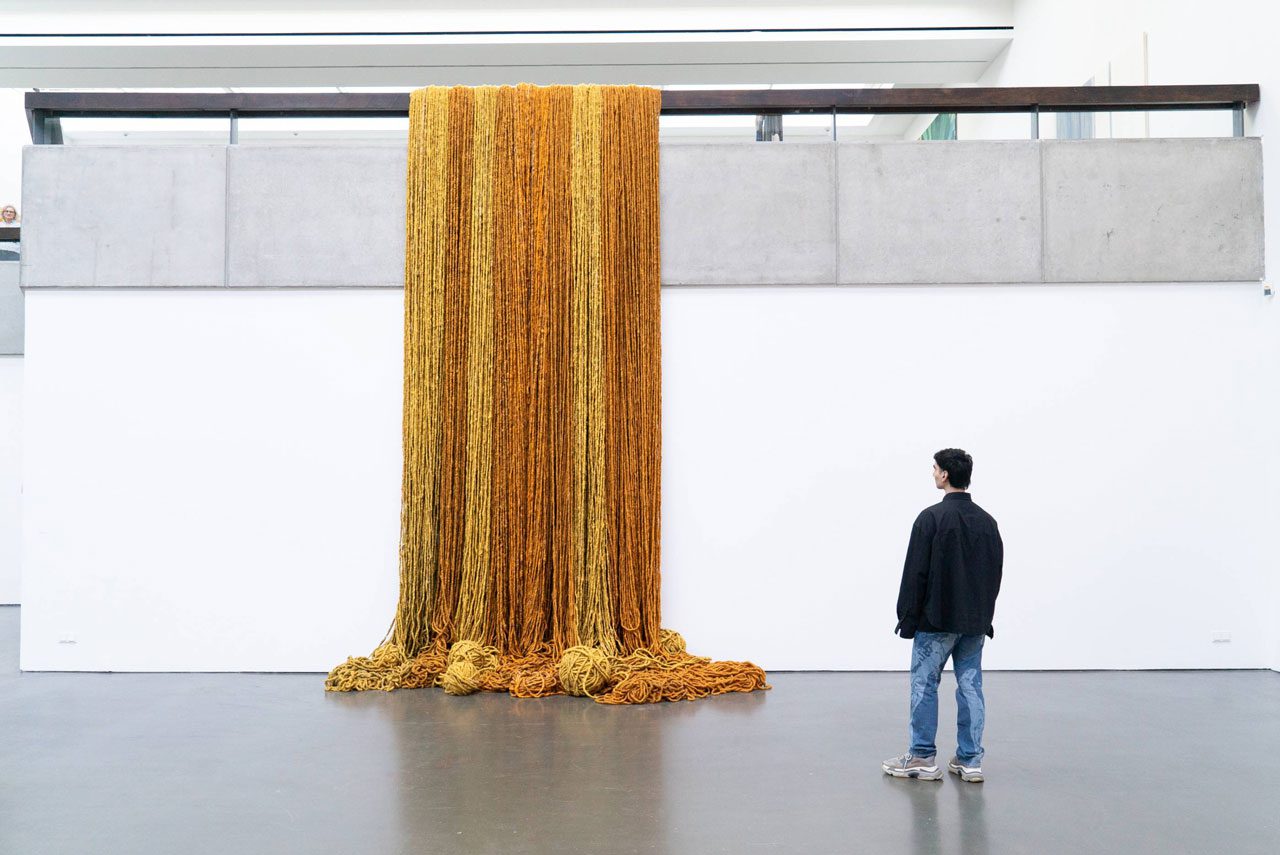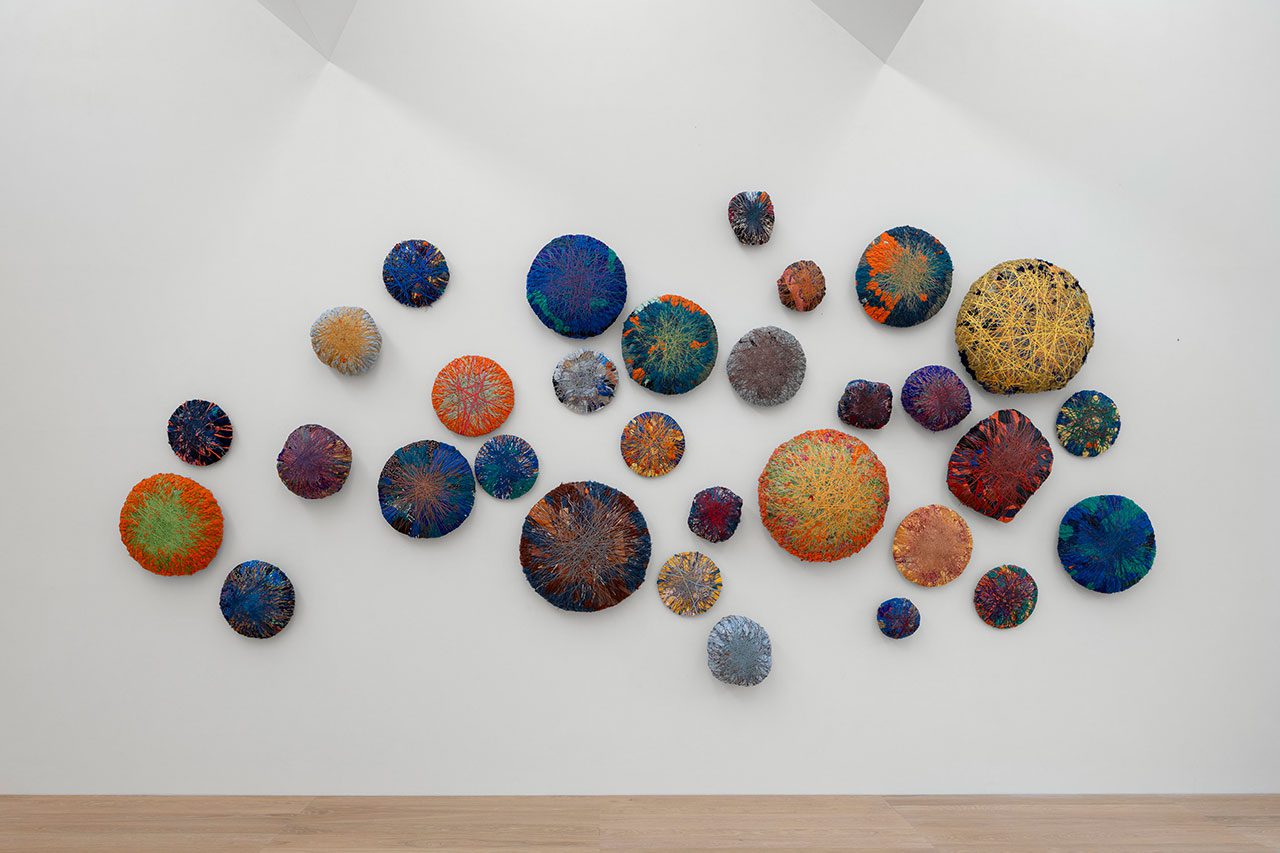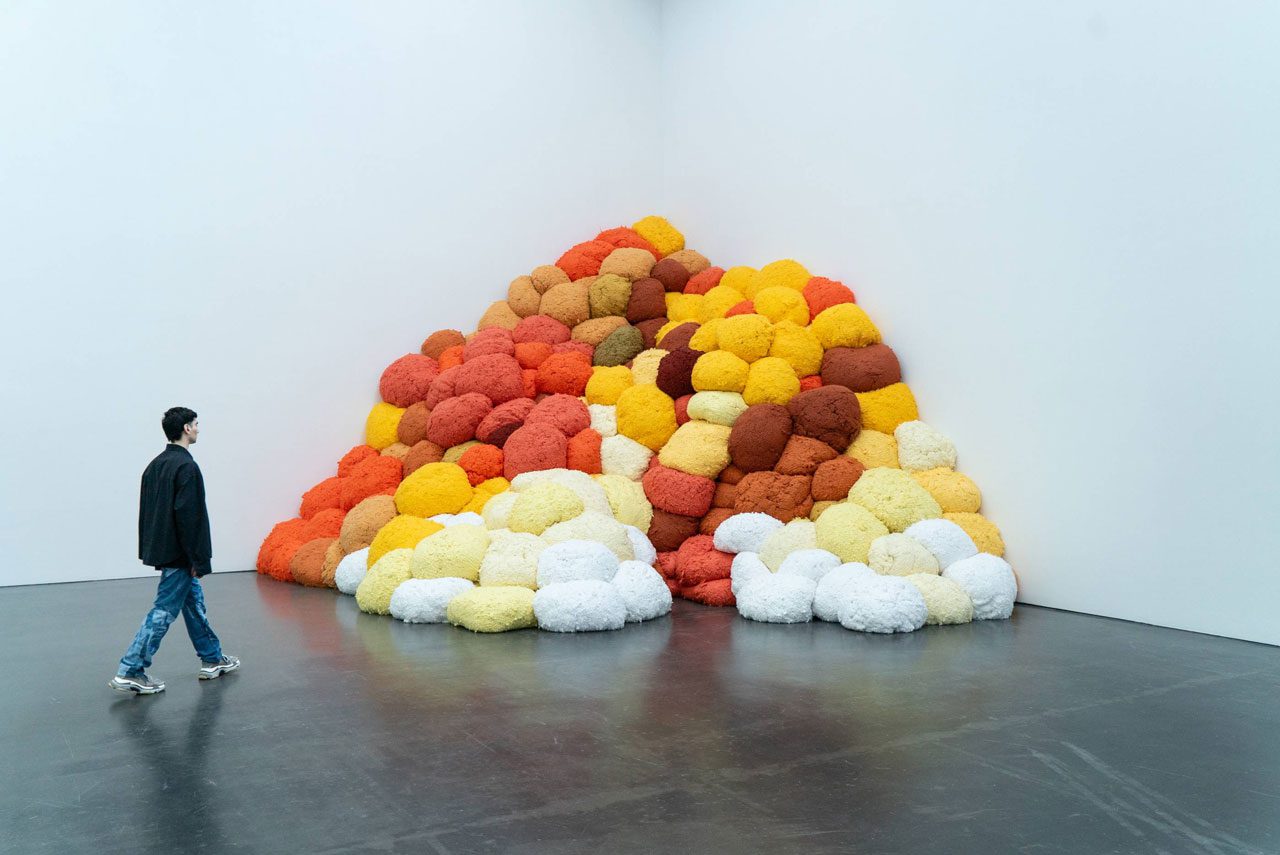PRESENTATION: Sheila Hicks
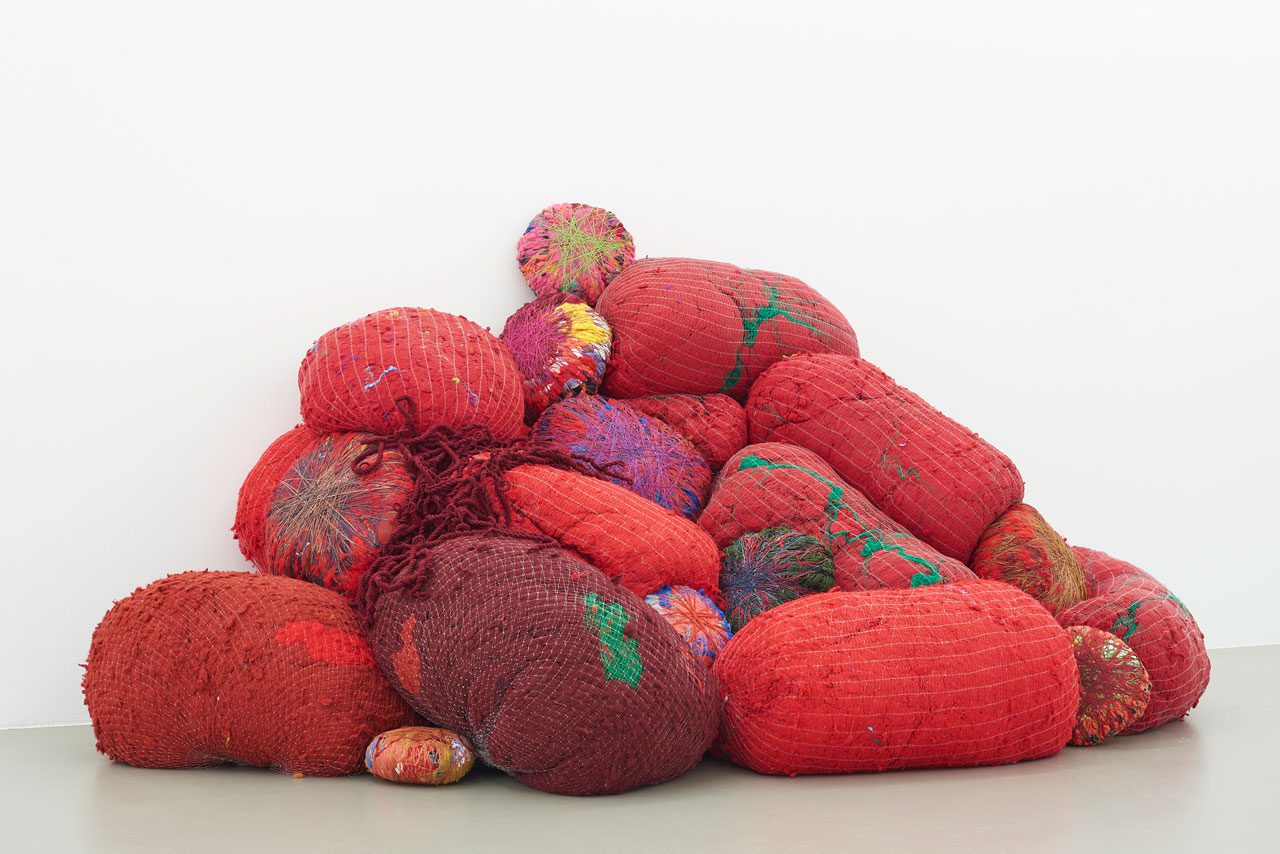 Born during the Great Depression in Hastings, Nebraska, Sheila Hicks spent much of her early life on the road, with her father seeking work where he found it. This “fantastic…migratory existence,” as she has described it, has come to define her six-decade career as an artist. Extensive experiences traveling, living, and working around the world continue to advance her exploration of textiles, the pliable and adaptable medium with which she is most closely associated.
Born during the Great Depression in Hastings, Nebraska, Sheila Hicks spent much of her early life on the road, with her father seeking work where he found it. This “fantastic…migratory existence,” as she has described it, has come to define her six-decade career as an artist. Extensive experiences traveling, living, and working around the world continue to advance her exploration of textiles, the pliable and adaptable medium with which she is most closely associated.
By Efi Michalarou
Photo: Kunsthalle Düsseldorf Archive
Photo: Josef Albers Museum Quadrat Bottrop Archive
Held jointly at the Josef Albers Museum in Bottrop and the Kunsthalle Düsseldorf, the exhibition “Sheila Hicks” presents the artist’s entire oeuvre. Josef Albers Museum features a retrospective that spans from 1955 to 2024, placing her work in dialog with works of Hicks’ teacher, Josef Albers, from their collection. Kunsthalle Düsseldorf, in turn, offers a broader perspective on her current artistic production. All three exhibition spaces are mainly devoted to works from the last 20 years. The monumental and intense power of her large-scale, site-specific installations, wall pieces and sculptures unfolds through their interaction with the brutalist architecture of the exhibition spaces. “What can you do with a thread?” is the provocation the artist has spent a lifetime investigating. In her pursuits, she has developed a wide spectrum of techniques that continuously surprise and upend our perception and concepts of art and textiles, color and structure, artwork and space, often with humour. Driven by curiosity, she has pioneered new territory painting with threads and sculpting with yarns by connecting the eyes with the hands. On numerous travels throughout the world, from the United States to Mexico, South America, India, Morocco, the Middle East, Japan, South Africa, Korea and France, she has engaged with local artists, craft businesses and poets, collaborating with them and learning from them. Undeniably, many of the concepts she has developed are traceable throughout her encounters and the incredible abundance of knowledge of global textile history and traditions manifests itself in extraordinary ways in her work. That can be categorized in these themes. “Boules”: The “Boules” are textiles wrapped with colored threads, reminiscent of tied-up parcels. Sheila Hicks wraps threads of different types and colors around a central core, often an item of clothing, but also objects that are significant to her. This wrapped form has its origins in pre-Incan tombs, where the mummified individuals and their most important possessions were enveloped in layers of textile. The “Boules” come in various sizes and color spectrums. The varying color effects of the different threads give them an extraordinary luminosity, making them shine like small gemstones. Their presentation varies: sometimes displayed individually or grouped as an installation on the floor or a plinth or hung on the wall. Several works from this series are featured in the exhibition: the round wall pieces “Freshly unearthed” (2023–2024), “Planet ten” (2023), “Planet eleven” (2023), among others, which, with a diameter of around one meter, resemble medallions or shields, or are referred to as comets by the artist. Smaller Boules are presented in a display case, which is typically found in Hicks’ studio in Paris. Many of the ideas and concepts she explored early in her career have continued to evolve. The formal language created for the “Boules” can also be found in other large-scale installations: the monumental, expansive work “Saffron Sentinel” (2017) consists of bundled piles of pure, pigmented fibers held together with fine nets. These sculptural works, which the artist creates in various colors and dimensions, enhances cohabitation between artwork and architecture. Columns: “Columns” is the name given to the monumental sculptures in Sheila Hicks’ work that are reminiscent of Greek and Egyptian columns. They consist of clusters of threads, which, grouped together to form columns, can extend to unlimited heights. The color palette of the Columns is broad: Hicks sometimes creates monochrome “Columns”, but often bright, colorful ones that reveal their spectrum when viewed from different angles. The “Columns” resemble soft architectural structures whose impact varies depending on how they are displayed. Some are free-standing, while others are suspended from the ceiling. Outdoors, they seem to rise towards a crack in the clouds, while indoors they appear to transcend spatial boundaries, as though breaking through the ceiling. Each work is continually reimagined based on the conditions of the exhibition spaces. Hicks is presenting one monochrome “Column” at Kunsthalle Düsseldorf: “Au-delà” (2022). The work “Aprentizaje de la Victoria” (2008–2016) is related to the “Columns” in its technique, but here, the bundles of threads cascade like a waterfall over the balcony of Kunsthalle Düsseldorf. Lianes: Hicks made her first “Lianes” for “vines”) in the 1960s. They consist of bundled strands of wool, linen, cotton or synthetic fibers tightly wrapped at regular intervals. This technique is inspired by the ikat dyeing process, where individual or bundled threads are wrapped before dyeing so that the tied areas remain uncolored. Repeated tying and dyeing create a complex pattern when woven into fabrics. While the wrapped sections of the Lianes are rigid and shiny, the untied threads are soft and flowing; the contrast emphasizes the different material qualities. The distance between the bindings and the length of the ties determine the formal character of each piece. These works are displayed in various ways: sometimes hanging freely from the ceiling, draped over plinths, or installed floating in front of or on the wall. Hicks views the Lianes as open compositions; their presentation and dimensions change based on spatial conditions. As expansive installations, they are closely connected to the architectural environment. The exhibition features the wall pieces “Marching to your Music” (2023), “Himalayas Horizon” (2022) and “Labyrinthe du Paradis” (2024), as well as the freestanding sculpture “Amsterdam” (2014).
Minimes: Hicks began exploring weaving structures while studying at the Yale School of Art with improvised looms, through which she created her first “Minimes”, or miniatures. She has produced over a thousand miniatures to date, which are small-format, intimate, playful works made of wool, silk or linen, among other materials. Often made while traveling, Hicks incorporates souvenirs such as shells, stones or human hair, as well as wood, metal, feathers and rubber. The “Minimes” can be viewed as diary entries, responses to what she has seen and experienced, and explorations of textile structures. Many miniatures directly reference places or encounters from her travels. Their titles often hint at the origins of the works but are more metaphorical than descriptive. The “Minimes” are varied and complex. Though independent works, they function as a kind of laboratory and are often later incorporated into her large-scale pieces. Talking Sticks: In many societies in Northwest America, West and Central Africa and Oceania, talking sticks (or speaker’s staffs) decorated with carvings or paintings are used to indicate who has the right to speak in gatherings. During debates, these speaker’s staffs are passed from person to person. Sheila Hicks’ “Talking Sticks” are bamboo canes of various lengths, wrapped in multicolored fibers. These works consist of groupings of these sticks, arranged in varying formations. Sometimes only a few rods hang lightly, partially crossing one another on the wall, while other times a multitude of rods hang close together or are presented as an installation leaning against the wall. The work “Right to Speak” (2022) is featured in the exhibition. The title refers both to the origin of the talking sticks and to freedom of expression. The work “Torsade – Verdreht” (2017) is also part of the series, while the piece “Palitos con Bolas “(2023) (Spanish for “sticks with balls”) combines elements of “Boules” with those of the “Talking Sticks”. Bas-reliefs: In addition to these groups of works, Sheila Hicks’ versatile œuvre encompasses other creative areas that she constantly develops and rethinks. Several bas-reliefs are displayed in the Emporensaal at Kunsthalle Düsseldorf: The works “Zeus” (2022), “Paros” (2022), “Sunrise in Machu Picchu” (2020), “Voltaire” (2018) and “Epidaurus” (2022) are part of a series of large canvases wrapped in linen that appear both sculptural and picturesque. The works “Andros” (2024), “Double Talk” (2023) and “Delphi” (2023), which are exhibited for the first time, also create relief patterns by interweaving the linen. Additionally, smaller experiments on canvas, which have made their way directly from the artist’s studio into the exhibition, are also on display: “Peignage” (2015), “Camarades” (2023), “Hera” (2020), “KH” (2024) and “HK” (2024). Further series of works are also on view: In the late 1970s, Sheila Hicks also began working with found textiles, reflecting her interest in the social characteristics of fabrics, particularly used textiles. She created sculptures from items like hospital uniforms, military clothing or baby clothes, often collaborating with local communities during the creative process and returning the fabrics to their original places after use. The exhibition features two fishing nets as floor works that Hicks discovered at a flea market in Korea in 1991, the work “Le Démêloir: (1977) made from linen cloths found and embroidered by the artist, as well as the new work “Left: (2024), which she created using textiles found at Kunsthalle Düsseldorf. The monumental tapestry “Le Palmier” (1984–1985) is the only work by Sheila Hicks from the 1980s to be shown at Kunsthalle Düsseldorf and thus, together with few other works created before 2000, represents a direct link to the exhibition at Josef Albers Museum Quadrat Bottrop. In addition to the series of works presented at Kunsthalle Düsseldorf, their exhibition showcases the “Prayer Rugs” series and groups of “Fajas”, elaborately woven sashes and “Quipu” textile communication tools – both originating from the tribes of the Andes. Along with works spanning her entire career, the retrospective includes accompanying visual and archival material, such as paintings from her student days and her thesis from Yale School of Art, a study of pre-Incan weaving techniques.
Photo: Sheila Hicks, Rempart, 2016, Pigmented acrylic fiber, Variable dimensions© VG Bild-Kunst, Bonn 2024 – Courtesy of the artist, Meyer Riegger, Berlin/Karlsruhe/Basel, and galerie frank elbaz, Photo: Oliver Roura
Info: Kunsthalle Düsseldorf, Grabbeplatz 4, Düsseldorf, Germany, Duration: 12/20/2024-23/2/2025, Days & Hours: Tue-Sun 11:00-18:00, www.kunsthalle-duesseldorf.de/ & Josef Albers Museum Quadrat, Anni-Albers-Platz 1, Bottrop, Germany, Duration: 12/20/2024-23/2/2025, Days & Hours: Tue-Sat 11:00-17:00, Sun 10:00-17:00, www.bottrop.de/




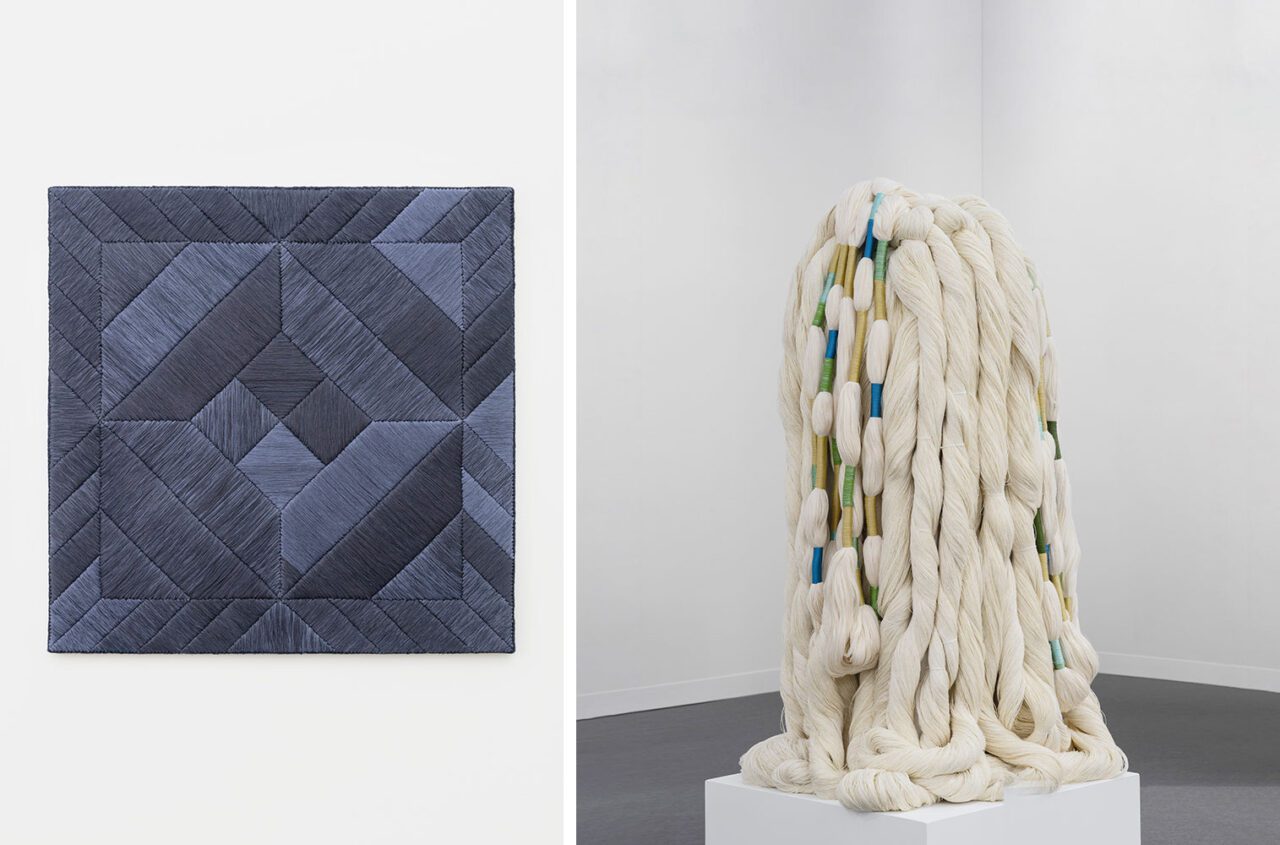
Right: Sheila Hicks, Only snow can save us, 2013/2023, Linen, cotton and silk, 120 x 60 x 50 cm© VG Bild-Kunst, Bonn 2024 – Courtesy of the artist and galerie frank elbaz, Photo: Claire Dorn
